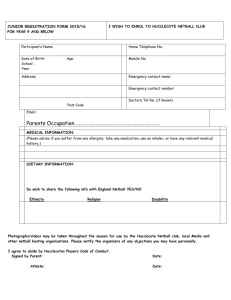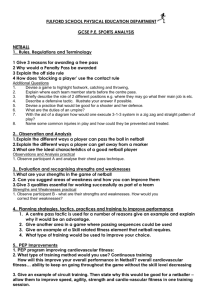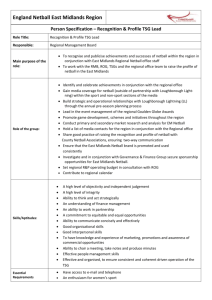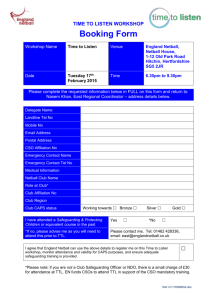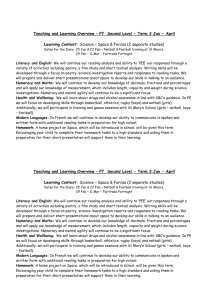WORD - Australian Human Rights Commission
advertisement
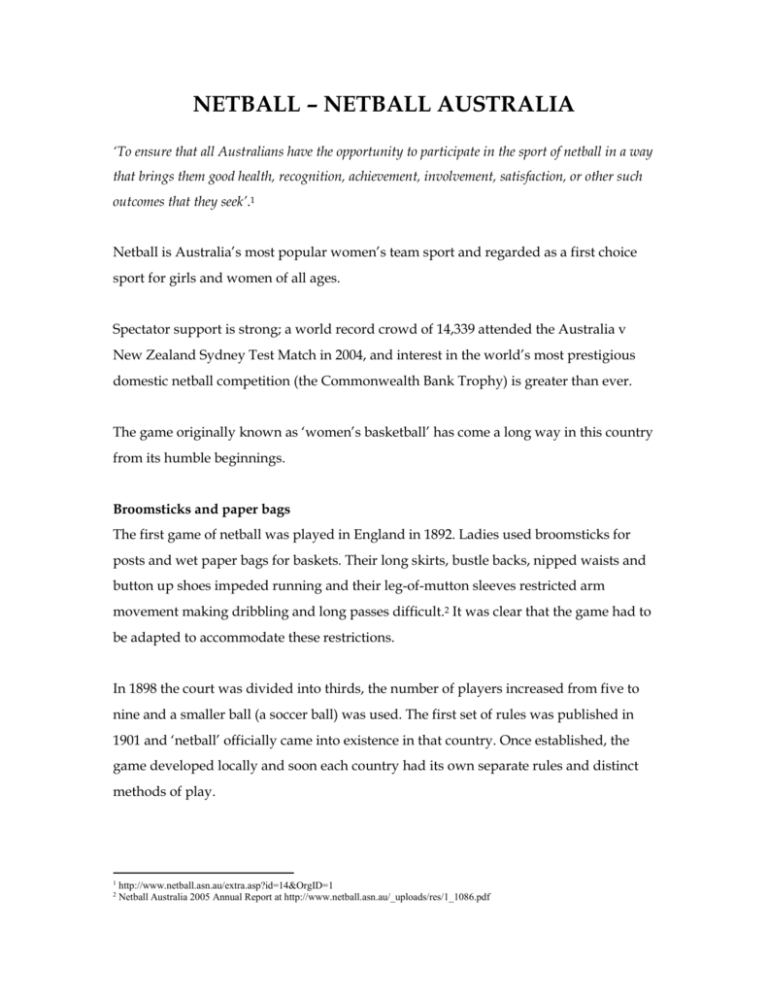
NETBALL – NETBALL AUSTRALIA ‘To ensure that all Australians have the opportunity to participate in the sport of netball in a way that brings them good health, recognition, achievement, involvement, satisfaction, or other such outcomes that they seek’.1 Netball is Australia’s most popular women’s team sport and regarded as a first choice sport for girls and women of all ages. Spectator support is strong; a world record crowd of 14,339 attended the Australia v New Zealand Sydney Test Match in 2004, and interest in the world’s most prestigious domestic netball competition (the Commonwealth Bank Trophy) is greater than ever. The game originally known as ‘women’s basketball’ has come a long way in this country from its humble beginnings. Broomsticks and paper bags The first game of netball was played in England in 1892. Ladies used broomsticks for posts and wet paper bags for baskets. Their long skirts, bustle backs, nipped waists and button up shoes impeded running and their leg-of-mutton sleeves restricted arm movement making dribbling and long passes difficult.2 It was clear that the game had to be adapted to accommodate these restrictions. In 1898 the court was divided into thirds, the number of players increased from five to nine and a smaller ball (a soccer ball) was used. The first set of rules was published in 1901 and ‘netball’ officially came into existence in that country. Once established, the game developed locally and soon each country had its own separate rules and distinct methods of play. 1 2 http://www.netball.asn.au/extra.asp?id=14&OrgID=1 Netball Australia 2005 Annual Report at http://www.netball.asn.au/_uploads/res/1_1086.pdf In 1960, the International Federation of Women’s Basketball and Netball Associations was established at a conference in Ceylon (Sri Lanka) attended by representatives from England, Ceylon, South Africa, West Indies, New Zealand and Australia. The first world tournament followed in 1963, with 11 teams competing. The event was held in England and Australia was undefeated. World Championships are staged every four years and Australia has the titleholder on eight occasions.3 There are 41 nations presently affiliated to the International Federation of Netball Associations (IFNA), grouped into five regions (Africa, Asia, Americas, Europe and Oceania) and each with their own regional federation. IFNA is responsible for the rules of netball, which is now played by an estimated 7 million people worldwide. The game has more active participants within the Commonwealth than any other sport.4 Netball was a demonstration sport at the Auckland Commonwealth Games in 1990, but it was not until 1998 that the sport was included in the official Commonwealth Games program in Kuala Lumpur. Australia won the Commonwealth Games Gold medal that year and again in 2002, then took the silver medal against New Zealand at the 2006 Melbourne Commonwealth Games. Netball in Australia In Australia and New Zealand, where the game was established before 1901, netball was originally called ‘women’s basketball’.5 The All Australia Women’s Basketball Association (AAWBA) was formed in August 1927, with the first official national championships held in Melbourne the following year. Australia’s first International match was played against New Zealand in Melbourne in 1938, a game which Australia won. 3 http://www.netball.asn.au/extra.asp?id=30&OrgID=1 http://www.netball.asn.au/extra.asp?id=30&OrgID=1 5 http://www.netball.asn.au/extra.asp?id=30&OrgID=1 4 In 1970 the name of the game was changed to ‘netball’ and the word ‘women's’ was deleted, which resulted in a change of name from the AAWBA to the All Australia Netball Association (AANA).6 The AANA then changed its name to Netball Australia in 1993. Netball Australia Netball Australia is the national sporting organisation responsible for the development, promotion, governance and control of netball throughout Australia. In conjunction with its eight state and territory members, the national body oversees all levels of participation and competition, including the management of player pathways, elite competitions, and the national coaching and umpiring programs. At the domestic level, the sport provides playing opportunities for boys and girls starting from as young as five years (through the Fun Net program) and NETTA Netball for children aged 8-10 years. Traditionally an outdoor sport played at local courts throughout Australia, over recent years there has also been growth in indoor netball, summer (evening) tournaments and mixed netball competitions. The National Netball League (the Commonwealth Bank Trophy), now in its 10th year, is the domestic showcase for the sport. Eight teams from six states and territories play from May- September, with matches telecast on ABC-TV and ABC2. High level programs for coach and umpire education, and training and development are run under the auspices of Netball Australia and its state and territory members. In a move to enhance promotion of the sport, Netball Australia will move its headquarters from Sydney to Melbourne in January 2007 to work with the AFL. They will share some facilities and services, with the two sporting bodies also planning to work together on programs such as modified rules competitions for children. 6 http://www.netball.asn.au/extra.asp?id=12&OrgID=1 AFL chief executive Andrew Demetriou said "I think people are aware that we've got great similarities with netball. We've got very high participation, we've got state bodies, we have already demonstrated in Victoria, particularly in our country areas, that we share facilities and share clubs. It makes sense that two key sporting bodies like the AFL and Netball Australia get together and work towards a common purpose”.7 For pragmatic reasons, AFL sides in Perth, Adelaide, Melbourne, Sydney and Brisbane are starting to form partnerships with state netball counterparts which may ultimately develop into superclubs. In Perth, the West Coast Eagles (AFL) has been sponsoring the state's elite netball team ‘the Orieles’ for the past 12 months. West Coast makes no secret of the fact that the arrangement helps boost the club's community standing at a time when some of its players have attracted bad publicity off the field. Early in 2006, the oldest AFL club in the league Melbourne, became a partner with star netball team ‘the Phoenix’. One aspect of the partnership is that players from both clubs will do community projects together.8 Who plays netball? Netball competitions start with players aged as young as six years and go right up to masters competition played by people in their fifties and beyond. What used to be a girl’s game is fast becoming a game for everybody —young and old, men and women and able-bodied and people with disability. 9 Netball maintained its ranking as the sport with the fourth largest number of participants (509,000) in organised activities in 2005. The Australian Sports Commission’s member analysis indicates that juniors (58%) continue to represent the majority of the national membership, followed by seniors (37%), modified (3%) and nonplayers (2%).10 ‘Netball Australia moving to Melbourne’ in SMH, September 7, 2006 at http://www.smh.com.au/news/SPORT/Netball-Australiamoving-to-Melbourne/2006/09/07/1157222251421.html 8 http://www.abc.net.au/7.30/content/2006/s1732828.htm 9 http://www.ausport.gov.au/isp/nisdpnet.asp 10 Netball Australia 2005 Annual Report at http://www.netball.asn.au/_uploads/res/1_1086.pdf 7 There was 2.8% reduction in the number of nationally registered players and officials in 2005 down to 327,846. Despite this decrease, membership numbers in the last 10 years have remained relatively stable. 11 Netball Australia CEO Lindsay Cane says: “Netball has great cultural and sporting significance within the Australian community and we have a tremendously rich and diverse organisation to which we all belong”.12 The administration of netball is carried out by many individuals belonging to associations across the country. There are 569 regional associations across Australia which represents an estimated 5000 local clubs.13 Netball is also underpinned by an army of volunteers who provide loyal support and service to their clubs and associations. The strength of netball as Australia’s largest sport for women is reflected in this complex nationwide network of volunteer personnel. Netball Australia does not conduct a census to determine player membership or participation. As such there is no specific data on the number of Indigenous people or those from culturally and linguistically diverse backgrounds who participate in the sport. Catering for juniors Early netball experiences impact greatly on continued participation, so it is important to understand what motivates young people to stay involved in netball in order to develop and conduct programs which best cater for them. Netball Australia considers that ‘all young people should have the fundamental right to be physically active and participate within netball’. The organisation makes decisions based on ‘principles of equity so that individuals are not affected negatively by ability, 11 Netball Australia 2005 Annual Report at http://www.netball.asn.au/_uploads/res/1_1086.pdf Netball Australia 2005 Annual Report at http://www.netball.asn.au/_uploads/res/1_1086.pdf 13 http://www.netball.asn.au/extra.asp?id=17&OrgID=1 12 body shape, disability, ethnicity, gender and sexuality, geographical location and socioeconomic status’.14 A number of netball programs have been developed which can be adapted for young people from a variety of backgrounds. These programs also aim to address issues relating to access and equity. Ethnicity Netball Australia encourages the participation of young people from culturally and linguistically diverse (CLD) backgrounds in order to: • accommodate real or perceived differences in opportunities, • promote cultural diversity in netball experiences for all young people, • provide access to a wider cross section of the Australian population, • enable young people from diverse backgrounds to compete at the highest levels. Indigenous Australians Culturally relevant support offered by netball encourages participation by young Indigenous people in netball. Netball providers should: • encourage young Indigenous people to participate in sport, • provide help with coaching and resources, • offer places to gifted young Indigenous people in talent development programs. Socio-economic status Netball Australia considers that provisions should be made to allow and encourage young people from a wide cross section of society to participate in netball programs, which will benefit the individual participant and the sport. ‘Above all, young people must be treated with respect regardless of their capabilities and experience a safe and responsible environment led by caring netball providers. 14 Netball Australia Junior Netball Policy at http://www.netball.asn.au/_uploads/res/1_113.pdf Ultimately this will provide a rich netball experience for young people and result in continued retention of interest and support talent development’.15 The Junior Netball Framework includes an implementation strategies and checklist document designed to help clubs and associations assess their current practices and environment with web-based fact sheets on various topics. Junior programs Research from a number of areas has highlighted the need for young Australians to develop motor skills both in and out of the school environment. The provision of an age appropriate, staged progression for netball participation is an essential element in developing confident and skilled participants. 16 As a result, the following junior programs have been developed: FUN NET is a play-based motor skills program for 5-7 year olds held in a fun environment of games and activities. The program can be run between 8-16 weeks and be delivered by an association, club or school. Children join the program as individuals, not as teams, and the emphasis is on participation, developing skills and having fun. Refinement of skills and their application to the game is introduced when participants reach the next stage - NETTA Netball. NETTA Netball is the modified game for 8-10 year old boys and girls. It incorporates skill development and round-robin game play with the emphasis on participation and fun. It can also be delivered by clubs, associations or schools. NETTA Netball has been designed to meet the needs of children and gives them a chance to be successful and feel good about themselves. Other sports that have taken a similar 15 16 Netball Australia Junior Netball Policy at http://www.netball.asn.au/_uploads/res/1_113.pdf http://www.netball.asn.au/extra.asp?id=37&OrgID=1 approach include: Australian Football League (Auskick), Hockey (Minkey Hockey), Lacrosse (Sofcrosse) and Basketball (Ozball).17 Other junior initiatives Netball Australia, Cricket Australia and the Australian Football League, with the support of Medibank Private, introduced the Medibank Private 1Seven program to schools over the course of 2006. 1Seven is a national health and wellbeing program for Australian children aged 5-12 years. The free program includes health-related classroom curriculum and practical physical activities to develop key movement and motor skills. Innovative web-based resources are also made available to teachers and parents via www.1Seven.com.au. 18 There are also state programs in place such as Netball Queensland’s Net Set GO! – an initiative aimed at the grass roots and development level of junior netball. Net Set GO! provides an opportunity for children aged 5–12 years to increase their social and motor skills in a friendly, fun and safe environment. The program uses play-based games to provide maximum enjoyment for all involved. Each program involves six hours of coaching, divided into a number of sessions. The program supports Netball Australia junior programs and is run through Queensland netball associations and schools. 19 Netball Australia Indigenous Sport Program Netball Australia in conjunction with the Australian Sports Commission’s Indigenous Sport Program (ISP) provides opportunities for Indigenous people to become involved in netball through targeted programs run in the Northern Territory, Queensland and Western Australia. 17 http://www.netball.asn.au/extra.asp?id=36&OrgID=1 http://www.netball.asn.au/extra.asp?id=356&OrgID=1 19 http://netsetgo.netball.asn.au/ 18 Netball Australia’s National Coaching Director, development officers in the state and territory netball associations, various ISP development officers throughout the country and local state and territory departments of sport and recreation, have designed a program which focuses on active participation in playing, coaching and administration, while also providing access to facilities and equipment.20 In 2005, Netball Australia conducted research into the needs of Indigenous participants in an effort to increase Indigenous participation. The recommendations from the review are being considered in the development of a National Indigenous Strategy.21 It is envisaged that the national strategy will be developed and implemented throughout the wider Australian region within the next few years.22 Remote and regional community activities In June 2005, Netball Australia’s Chief Executive Officer Lindsay Cane and Commonwealth Bank Trophy netball players, Jane Altschwager (McDonald’s Hunter Jaegers) and Carla Dziwoki (Queensland Firebirds), flew into the remote Northern Territory coastal town of Maningrida to support the local community and strengthen its ties with netball. Maningrida, the second largest Aboriginal community in the Northern Territory and the only one with a schoolgirls netball team, is a unique town where 51 Indigenous languages are spoken by the residents. This joint initiative between Netball Australia and the Northern Territory Government saw elite Australian netballers conduct coaching clinics in the community. At the conclusion of the clinic, team apparel, netball equipment and coaching resources were donated to the community.23 20 http://www.netball.asn.au/extra.asp?id=38&OrgID=1 Netball Australia 2005 Annual Report at http://www.netball.asn.au/_uploads/res/1_1086.pdf 22 http://www.netball.asn.au/extra.asp?id=38&OrgID=1 23 Netball Australia media release ‘Remote Northern Territory community netball clinic’ 10 June 2005. 21 Lindsay Cane said: “The opportunity to support and encourage young talented women in rural communities, through role modelling and leadership through Australia’s elite players, is a testament to netball’s ethos. After realising how much rural communities can achieve with so little, we have come away from this experience strengthened in our resolve to continue to take our sport into rural Australian communities and build upon our commitment to recognise women athletes in Indigenous communities.”24 Another regional netball activity is the Charles Perkins National Football and Netball Championship Carnival. This annual national sporting event was named after Aboriginal leader Dr Charles Perkins. The carnival took place from 25-27 October 2005 in Darwin, with teams competing from all around Australia. Junior Indigenous strategies Netball Australia’s Junior Netball Policy has implementation strategies and a checklist for clubs and associations to help them ensure that they encourage and support Indigenous players to participate in netball. The checklist specifically asks: ‘Does your club/association offer opportunities for young Indigenous people to participate in netball?’ Strategies to support clubs to achieve this goal include: Link with Indigenous sport development officers in your local region and consult with Indigenous communities to assist in the establishment of netball competitions in Indigenous communities. Create policies that allow Indigenous teams to enter into the association competition. Encourage Indigenous kids to participate in all forms of the game (e.g. promote coaching, officiating and playing pathways). Contact your state and territory netball association for special programs or funding opportunities which may be available. 24 Netball Australia media release ‘A clinic that inspired a community’ 15 June 2005. The policy also asks: Does your club/association encourage people working with Indigenous young people to undertake cross-cultural awareness training? The strategy suggests to ‘host cross-cultural awareness training sessions (available through state/territory departments of sport and recreation) for all netball volunteers working with Indigenous young people’.25 Living in Harmony Netball Australia is a proud supporter of Harmony Day. As CEO, Lindsay Cane explains: “Our commitment to Harmony Day 2006 highlights and reinforces our commitment to a multicultural netball society within a culturally diverse and tolerant broader Australian community. We recognise and champion the principle of fair treatment and equal opportunity in sport, and the benefits arising from our diversity”. 26 Australia’s most capped netballer, Liz Ellis, also recently lent her time to record a 30second community radio service announcement to support Australia’s diversity as a nation and to encourage harmony within Australian communities. “I've played with a lot of people from a tremendous range of cultural backgrounds in my time. Harmony Day is about a fair go for everyone - no matter where they're from or what they look like,” said Ellis.27 Fostering inclusion Netball Australia embraces ethnic diversity in the community by encouraging the participation of all individuals from culturally and linguistically diverse (CLD) backgrounds. The organisation’s core values are to ‘treat all people with dignity and respect’, ‘embrace diversity’ and ‘be sharing, open, inclusive and cooperative’.28 25 Junior Netball Policy - Implementation strategies and checklist at http://www.netball.asn.au/_uploads/res/1_274.pdf ‘Netball Australia and Harmony Day’ on www.netball.asn.au 27 ‘Netball Australia and Harmony Day’ on www.netball.asn.au 28 http://www.netball.asn.au/extra.asp?id=14&OrgID=1 26 It urges clubs and associations to encourage cultural respect and diversity to attract people from different nationalities to participate in the game. Associations are also encouraged to make amendments to by-laws (if necessary) to allow all participants to play in a fair environment.29 Netball Australia’s Junior Netball Policy has a checklist and strategies which relate to ‘ethnicity’. The policy asks whether ‘clubs and associations offer opportunities for young people to participate in netball regardless of their ethnicity’? Suggested strategies include to: Be flexible to accommodate cultural and religious beliefs (e.g. relaxing uniform requirements, raising awareness of important religious/cultural events and practices, and scheduling competitions surrounding them). Conduct cross-cultural training programs for administrators/coaches/umpires and offer training programs to all members. Offer ‘come and try’ days in known, family-friendly environments, such as schools. Establish ethnic teams within the existing competition structure. Encourage parents from ethnic backgrounds to become involved – provide specific training for them.30 The policy then asks if ‘clubs and associations ensure a positive and welcoming culture for young people from varying ethnic backgrounds?’ The strategy suggests to: ‘include images of participants from varying ethnic backgrounds in all promotional material and consider providing promotional material in a range of languages’. The checklist goes on to ask whether the ‘club/association develops and dedicates programs specifically to encourage young people from CLD backgrounds to participate in sport?’ The strategy suggests that clubs ‘consult with community leaders and cultural groups and 29 http://www.netballvic.com.au/play_multicultural.htm 30 Junior Netball Policy - Implementation strategies and checklist at http://www.netball.asn.au/_uploads/res/1_274.pdf seek support for netball programs’ and ‘promote junior netball programs to CLD families or groups’.31 The policy also has a checklist covering ‘socioeconomic status’ which asks ‘does your club or association offer opportunities for young people to participate in netball regardless of their socioeconomic status?’ Suggested strategies include to: Offer low cost resources/programs for schools/clubs located in low socioeconomic areas. Provide/lend used balls/bibs to school groups/competing teams. Offer discounted/subsidised school clinics and travel arrangements to or from training/competition. Establish similarity between club and school uniforms (i.e. wear anything of a certain colour). ‘Used uniform swap’ - recycle old club/association uniforms. Offer financial subsidies for players in representative teams. Allow membership payments to be spread over the season for individuals. Investigate sponsorship. Create a variety of membership options (e.g. short season or family membership for club fees). The checklist also asks if ‘your club/association encourage community involvement in supporting young people from low socioeconomic areas?’ The strategy suggests to: Conduct fundraising events to attract the community into supporting young people from low socio-economic areas. Establish relationships with the PCYC/YMCA and encourage them to conduct netball programs. 31 Junior Netball Policy - Implementation strategies and checklist at http://www.netball.asn.au/_uploads/res/1_274.pdf Offer training and professional development opportunities for members of community organisations and other volunteers. Apply for funding via local councils or state governments. Junior Netball Policy During 2005, Netball Australia adapted the Junior Netball Policy, which aims to provide a safe, healthy and fun environment in which young people can participate in the game. The policy was developed in collaboration with the eight state and territory netball member organisations, together with coaches, teachers, parents and netball administrators. It applies to all junior netball programs covering participants aged 5-17 years. The policy is underpinned by a series of resources to assist local associations, clubs and schools with a means of quickly referencing key issues and strategies to assist in their implementation of the policy. Member Protection Policy Netball Australia is committed to ‘treating all people with respect, dignity and fairness’.32 These values - along with the basic right of all netball members to participate in an environment that is enjoyable, safe and healthy - has resulted in the organisation developing specific objectives to create a safer and more tolerant sporting environment. All major policies of Netball Australia have been assessed - and are being revised where necessary - to ensure the organisation can successfully manage netball into the future.33 The recent development and adoption of the Member Protection Policy reflects Netball Australia’s commitment to serving and protecting its members and participants throughout all levels of the sport. This policy is one component of the overall strategy, which complements a range of other organisational policies including junior netball, umpire development, governance, finance, information technology and privacy policies. 32 33 http://www.netball.asn.au/extra.asp?id=14&OrgID=1 Netball Australia 2005 Annual Report at http://www.netball.asn.au/_uploads/res/1_1086.pdf Codes of Behaviour The Netball Australia Board and National Council adopted National Codes of Behaviour in 2004. The codes include a selection of key principles upon which coaches, teachers, umpires, administrators, parents and young players should base their netball involvement. They ensure that young people develop good sporting behaviours and enjoy a positive netball experience, which will encourage them to remain involved in the sport for longer. Netball Australia strongly promotes the adoption of these codes by associations, clubs and schools, and distributes them to all relevant parties at the start of every netball season. In addition to Netball Australia’s General Code of Behaviour, junior players must meet the requirements outlined in the Player Code of Conduct. Of relevance to the project, the code states that ‘verbal abuse of officials or other players, deliberately fouling or provoking an opponent and throwing/damaging equipment is not acceptable or permitted’ and to ‘treat all players, as you would like to be treated’.34 The Coaches Code of Conduct asks coaches to ‘encourage players to respect one another and to expect respect for their worth as individuals regardless of their level of play’ and to ‘treat all players fairly within the context of their sporting activities, regardless of gender, race, place of origin, athletic potential, colour, sexual orientation, religion, political beliefs, socio-economic status, and other condition’.35 The parent or guardian of a player in any activity held by Netball Australia must also abide by a code of conduct, including to ‘recognise and respect the value and importance of volunteer administrators, coaches and umpires. They give up their time and resources to provide recreational activities for players and deserve your support’. 34 35 http://www.netball.asn.au/_uploads/res/1_134.pdf http://www.netball.asn.au/_uploads/res/1_148.pdf Parents and guardians are expected to ‘be a model of good sports behaviour for children to copy’.36 Teacher’s must also abide by a code of conduct which asks them to ‘create opportunities to teach appropriate sports behaviour as well as basic skills’ and ‘help young people understand that playing by the rules is their responsibility’.37 A code of conduct for administrators states they should ‘develop a positive sport environment by allowing for the special needs of the players (especially children), by emphasising enjoyment and by providing appropriate development and competitive experiences’ and ‘where appropriate, distribute a code of behaviour sheet to coaches, players, umpires, parents, spectators and the media’.38 Umpires also have a code of conduct and they must ‘treat all players with respect at all times’ and ‘refrain from any form of harassment towards players’. 39 36 http://www.netball.asn.au/_uploads/res/1_155.pdf http://www.netball.asn.au/_uploads/res/1_162.pdf 38 http://www.netball.asn.au/_uploads/res/1_169.pdf 39 http://www.netball.asn.au/_uploads/res/1_176.pdf 37
